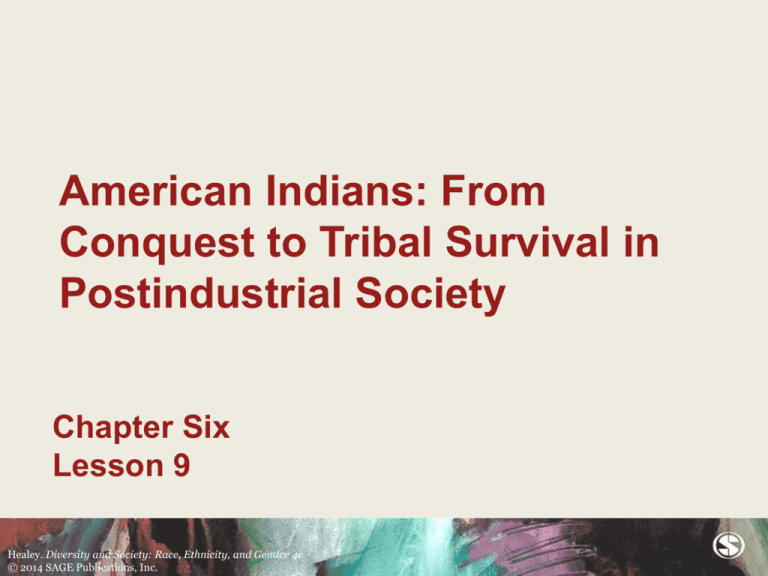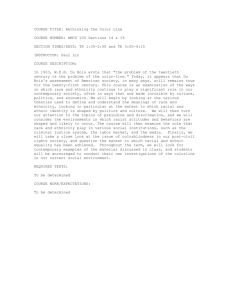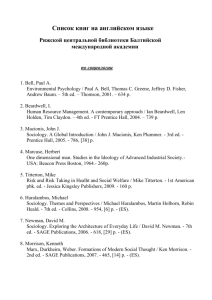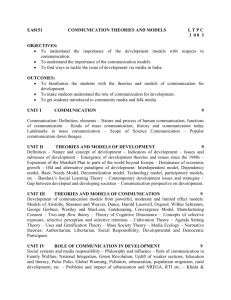chapter 5 - Cheerfulrobot.com
advertisement

American Indians: From Conquest to Tribal Survival in Postindustrial Society Chapter Six Lesson 9 Healey. Diversity and Society: Race, Ethnicity, and Gender 4e © 2014 SAGE Publications, Inc. Tribal Survival? • • • The contact period for American Indians lasted nearly 300 years, ending with the Indian Wars of the late 1800s. At the dawn of the 20th century, American Indians were a conquered and colonized minority group living on paternalistic government controlled reservations on the fringes of development and change, marginalized, relatively powerless, and isolated. At the dawn of the 21st century, American Indians remain among the most disadvantaged, poorest, and most isolated of minority groups, however, the group is not without resources and strategies for improving their situation. Healey. Diversity and Society: Race, Ethnicity, and Gender 4e © 2014 SAGE Publications, Inc. Size of the Group • • There were 5 million people who claimed at least some American Indian or Alaska Native ancestry but only about 2.5 million if we confine the group to people who select one race only. By either count, the group is a tiny minority (about 1%) of the total population of the United States. Healey. Diversity and Society: Race, Ethnicity, and Gender 4e © 2014 SAGE Publications, Inc. American Indian and Alaska Native Population 1900-2010 Healey. Diversity and Society: Race, Ethnicity, and Gender 4e © 2014 SAGE Publications, Inc. American Indian Cultures • • • The dynamics of American Indian and Anglo-American relationships have been shaped by the vast differences in culture, values, and norms between the two groups. There were (and are) hundreds of different tribes each with its own language and heritage. However, some patterns and cultural characteristics are widely shared across the tribes, and we will concentrate on these similarities. Healey. Diversity and Society: Race, Ethnicity, and Gender 4e © 2014 SAGE Publications, Inc. American Indian Cultures • • • • • The goal of many American Indian tribes was to live in harmony with the natural world, not “improve” it or use it for their own selfish purposes. The concept of private property, or the ownership of things, was not prominent in American Indian cultures. American Indian cultures and societies also tended to be more oriented toward groups than toward individuals. Many American Indian tribes were organized around egalitarian values that stressed the dignity and worth of every man, woman, and child. These differences in values, compounded by the power differentials that emerged, often placed American Indians at a disadvantage when dealing with the dominant group. Healey. Diversity and Society: Race, Ethnicity, and Gender 4e © 2014 SAGE Publications, Inc. Relations with the Federal Government after the 1890s • • Reservations were paternalistically controlled and corrupted by the Bureau of Indian Affairs (BIA) of the U.S. Department of the Interior. American Indians on the reservations were subjected to coercive acculturation or forced Americanization. Dawes Allotment Act of 1887 Boarding Schools • American Indians were virtually powerless to change the reservation system or avoid the campaign of acculturation, nonetheless, they resented and resisted and many languages and cultural elements survived the early reservation period. Healey. Diversity and Society: Race, Ethnicity, and Gender 4e © 2014 SAGE Publications, Inc. Relations with the Federal Government after the 1890s Healey. Diversity and Society: Race, Ethnicity, and Gender 4e © 2014 SAGE Publications, Inc. Relations with the Federal Government after the 1890s • • American Indian women also migrated to the city in considerable numbers, and often carried the burden of supporting the family as urban discrimination, unemployment, and poverty made it difficult for the men to fulfill the role of breadwinner. American Indian women in the city continue to practice their traditional cultures and maintain the tribal identity of their children despite difficulties inherent in combining child rearing and a job outside the home (Joe & Miller, 1994, p. 186). Healey. Diversity and Society: Race, Ethnicity, and Gender 4e © 2014 SAGE Publications, Inc. Protest and Resistance • The modern protest movement has focused on several complementary goals: protecting American Indian resources and treaty rights, striking a balance between assimilation and pluralism, and finding a relationship with the dominant group that would permit a broader array of life chances without sacrificing tribal identity and heritage. Healey. Diversity and Society: Race, Ethnicity, and Gender 4e © 2014 SAGE Publications, Inc. Protest and Resistance • • • As the pan-tribal protest movement forged ties between members of diverse tribes, the successes of the movement and changing federal policy and public opinion encouraged a rebirth of commitment to tribalism and “Indian-ness.” American Indians were simultaneously stimulated to assimilate (by stressing their common characteristics and creating organizational forms that united the tribes) and to retain a pluralistic relationship with the larger society (by working for self-determination and enhanced tribal power and authority). Thus, part of the significance of the Red Power movement was that it encouraged both pan-tribal unity and a continuation of tribal diversity (Olson & Wilson, 1984, p. 206). Healey. Diversity and Society: Race, Ethnicity, and Gender 4e © 2014 SAGE Publications, Inc. The Continuing Struggle for Development in Contemporary American Indian-White Relations • • • Many efforts to develop the reservations have focused on creating jobs by attracting industry through such incentives as low taxes, low rents, and a low-wage pool of labor The jobs that have materialized are typically low wage and have few benefits; usually, non-Indians fill the more lucrative managerial positions. These new jobs may transform “the welfare poor into the working poor” (Snipp, 1996, p. 398), but their potential for raising economic vitality is low. Healey. Diversity and Society: Race, Ethnicity, and Gender 4e © 2014 SAGE Publications, Inc. The Continuing Struggle for Development in Contemporary American Indian-White Relations • • • Another potential resource for American Indians is the gambling industry, which was made possible by 1988 federal legislation. Various tribes have sought other ways to capitalize on their freedom from state regulation and taxes—selling cigarettes tax-free and exploring the possibility of housing nuclear waste and other refuse of industrialization. Without denying the success stories, the lives of most American Indians continue to be limited by poverty and powerlessness, prejudice, and discrimination. Healey. Diversity and Society: Race, Ethnicity, and Gender 4e © 2014 SAGE Publications, Inc. Poverty and Education for NonHispanic Whites Healey. Diversity and Society: Race, Ethnicity, and Gender 4e © 2014 SAGE Publications, Inc. Median Household Income Healey. Diversity and Society: Race, Ethnicity, and Gender 4e © 2014 SAGE Publications, Inc. Contemporary American Indian-White Relations • • • Anti-Indian prejudice has been a part of American society from the beginning. One stereotype, especially strong during periods of conflict, depicts Indians as bloodthirsty, ferocious, and inhumanly cruel savages capable of any atrocity. The other image of American Indians is that of “the noble redman” who lives in complete harmony with nature and symbolizes goodwill and pristine simplicity (Bordewich, 1996, p. 34). Healey. Diversity and Society: Race, Ethnicity, and Gender 4e © 2014 SAGE Publications, Inc. Contemporary American Indian-White Relations • • A variety of studies have documented continued stereotyping of Native Indians in the popular press, textbooks, the media, cartoons, and various other places (for example, see Bird, 1999; Rouse & Hanson, 1991). The persistence of stereotypes is illustrated by continuing controversies surrounding nicknames for athletic teams and the use of American Indian mascots, tomahawk “chops,” and other practices offensive to many American Indians. Healey. Diversity and Society: Race, Ethnicity, and Gender 4e © 2014 SAGE Publications, Inc. Contemporary American Indian-White Relations • • • The very limited evidence available from social distance scales suggests that overt anti-Indian prejudice has declined. The situation of American Indian women is also underresearched, but like their counterparts in other minority groups and the dominant group, they “are systematically paid less than their male counterparts in similar circumstances” (Snipp, 1992; p. 363). Research is unclear about the severity or extent of discrimination against American Indians, but institutional discrimination is a major barrier for American Indians. Healey. Diversity and Society: Race, Ethnicity, and Gender 4e © 2014 SAGE Publications, Inc. Contemporary American Indian-White Relations • • • The huge majority (75%) of American Indians in the continental U.S. speaks only English but a sizeable minority (18%) speaks a tribal language as well. For most of the ten largest tribes, less than 10% speak their tribal language in addition to English. In some tribes, however, the picture is dramatically different. Healey. Diversity and Society: Race, Ethnicity, and Gender 4e © 2014 SAGE Publications, Inc. Contemporary American Indian-White Relations • • American Indians have been considerably more successful than African Americans in preserving their traditional cultures, due to the differences in their relationships to the dominant group. However, a number of social forces are working against pluralism and the survival of tribal cultures. Pan-tribalism may threaten the integrity of individual tribal cultures. Opportunities for jobs, education, and higher incomes draw American Indians to more developed urban areas and will continue to do so as long as the reservations are underdeveloped. Healey. Diversity and Society: Race, Ethnicity, and Gender 4e © 2014 SAGE Publications, Inc. Residential Segregation of American Indians 1980-200 Healey. Diversity and Society: Race, Ethnicity, and Gender 4e © 2014 SAGE Publications, Inc. Educational Attainment 2009 Healey. Diversity and Society: Race, Ethnicity, and Gender 4e © 2014 SAGE Publications, Inc. School Integration 1993-1994 and 2005-2006 Healey. Diversity and Society: Race, Ethnicity, and Gender 4e © 2014 SAGE Publications, Inc. Contemporary American Indian-White Relations • • • One positive development for the education of American Indians is the rapid increase in tribally controlled colleges, over 30 of which have been built since the 1960s. These institutions are mostly 2-year community colleges located on or near reservations, and some have been constructed with funds generated in the gaming industry. They are designed to be more sensitive to the educational and cultural needs of the group, and tribal college graduates who transfer to 4-year colleges are more likely to graduate than other American Indian students (Pego, 1998). Healey. Diversity and Society: Race, Ethnicity, and Gender 4e © 2014 SAGE Publications, Inc. Contemporary American Indian-White Relations • • • The ability of American Indians to exert power as a voting bloc very limited by group size, lower average levels of education, language differences, lack of economic resources, and factional differences within and between tribes and reservations. The number of American Indians holding elected office is minuscule, far less than 1% (Pollard & O’Hare, 1999, p. 41). In 1992, Ben Nighthorse Campbell of Colorado became the first American Indian to be elected to the U.S. Senate. He served in Congress until 2005. Healey. Diversity and Society: Race, Ethnicity, and Gender 4e © 2014 SAGE Publications, Inc. Contemporary American Indian-White Relations • • As in the case of African Americans, the overall unemployment rate for all American Indians is about double the rate for whites. For Indians living on or near reservations, however, the rate is much higher Unemployment is as high as 70% to 80% on some reservations. Healey. Diversity and Society: Race, Ethnicity, and Gender 4e © 2014 SAGE Publications, Inc. Median Household Income 2009 Healey. Diversity and Society: Race, Ethnicity, and Gender 4e © 2014 SAGE Publications, Inc. Distribution of Household Income Healey. Diversity and Society: Race, Ethnicity, and Gender 4e © 2014 SAGE Publications, Inc. Contemporary American Indian-White Relations • • • There is considerable variation from tribe to tribe but, as a whole, American Indians earn only about 75% of the national median income. Although the magnitude varies from tribe to tribe, about 22% of all American Indians and 27% of all American Indian children live below the poverty line. However, levels of poverty has fallen in recent decades and poverty tends to be much more prevalent in the reservation. Healey. Diversity and Society: Race, Ethnicity, and Gender 4e © 2014 SAGE Publications, Inc. Contemporary American Indian-White Relations • • • • Rates of intermarriage for American Indians are quite high compared with other groups. The higher rate of marriage outside the group for American Indians is partly the result of the small size of the group. Marriages with non-Indians are much more common in metropolitan areas, away from the reservations. They are also associated with higher levels of education, greater participation in the labor force, higher income levels, and lower rates of poverty (Snipp, 1989, pp. 160–164). Healey. Diversity and Society: Race, Ethnicity, and Gender 4e © 2014 SAGE Publications, Inc. Contemporary American Indian-White Relations • In comparing American Indians with African Americans: The differences in the stereotypes attached to the two groups are consistent with the outcomes of the contact period. Their contact situations were governed by very different dynamics and a very different dominant group agenda, which shaped subsequent relationships with the dominant group and the place of the groups in the larger society. While African Americans spent much of the 20th century struggling for inclusion and equality, American Indians were fighting to maintain or recover their traditional cultures and social structures. Healey. Diversity and Society: Race, Ethnicity, and Gender 4e © 2014 SAGE Publications, Inc. Progress and Challenges • • • American Indians are growing rapidly in numbers and are increasingly diversified by residence, education, and degree of assimilation. Some tribes have made dramatic progress over the past several decades, but enormous problems remain, both on and off the reservations. The challenge for the future, as it was in the past, is to find a course between pluralism and assimilation and pan-tribalism and traditional lifestyles that will balance the issues of quality of life against the importance of retaining an Indian identity. Healey. Diversity and Society: Race, Ethnicity, and Gender 4e © 2014 SAGE Publications, Inc.





